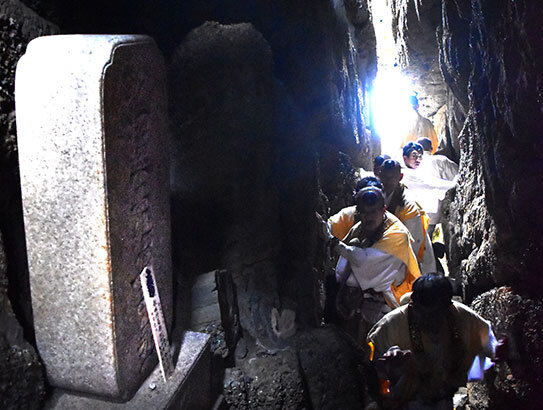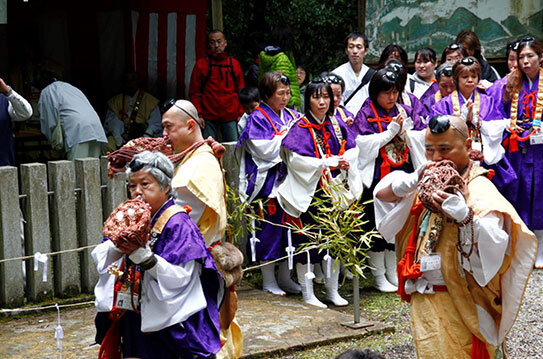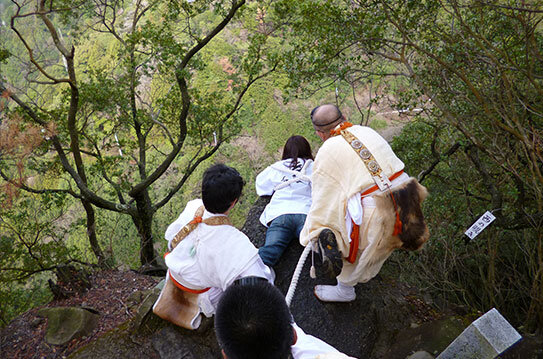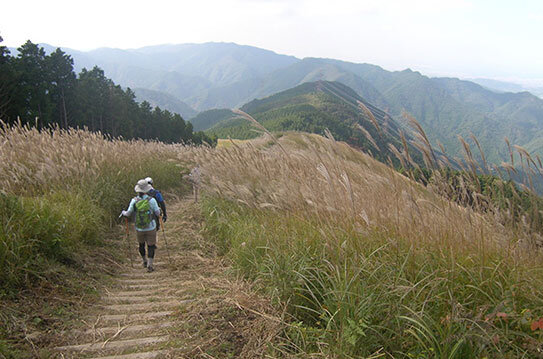The birthplace of Shugendo
The Izumi Range runs east to west along the boundary of Osaka and Wakayama Prefectures. The Kongo Range stretches north to south, dividing Osaka and Nara Prefectures. This 112-kilometer stretch of mountains is known as Katsuragi, and it has long been revered as a home to many deities.
En no Gyoja was born in the 7th century in present-day Gose, Nara, at the foot of the Katsuragi mountains. He is considered the founder of the Shugendo sect of mountain asceticism. Katsuragi is where he first practiced his training.
Mount Omine in Nara is part of the UNESCO World Heritage Site, "Sacred Sites and Pilgrimage Routes in the Kii Mountain Range." It is believed En no Gyoja moved here to continue his training after he founded Shugendo in Katsuragi (Katsuragi Shugen). Along with Katsuragi Shugen sites, Mount Omine is revered by Shugendo followers and seen as a place where they must undergo training.
Katsuragi is home to numerous temples and shrines that are connected to En no Gyoja in some way--temples he founded, temples that own Buddhist statues he created, places of worship where he is enshrined, the location of his mother's grave, and so on.
It is also said that En no Gyoja buried each of the chapters of the Lotus Sutra (28 chapters in eight volumes) in kyozuka (sutra mounds) across Katsuragi. Making a pilgrimage to these sutra mounds numbered 1 to 28--as well as to related waterfalls, megaliths, temples, and shrines--is called Katsuragi Shugen. The area where this practice takes place is also known as Katsuragi Shugen.
 Mount Yamato-Katsuragi
Mount Yamato-Katsuragi
Ascetic training begins by the sea
The first sutra mound, Johon, is located on Torajima, one of the four islands of Tomogashima off the coast of Kada, Wakayama. Given that Shugendo is a mountain-focused religion, it's unusual that one of its sacred training sites is by the ocean. While regular tourists take a ferry from nearby Okinoshima Island, Shugendo practitioners walk to Torajima across a rocky stretch that appears only at low tide.
Making your way across rocks and boulders--and taking care not to hit your head as you enter a narrow cave--you'll find the first sutra mound: a granite monument at about head height engraved with kanji saying it's the first chapter of the Lotus Sutra. Here, shugenja (Shugendo practitioners) blow their horagai (conch shell trumpet), light incense, recite sutras, and place a hide (wooden plaque) as proof of their visit. Written on the plaque are the shugenja's name and the date of the visit. Even today, you'll find plaques placed by shugenja from all over.
Kyozuka (sutra mounds) come in many shapes and sizes. They can be a stone monument like sutra mound #1, but they can also be a mini-shrine deep in the mountains or a boulder in a river that's large enough for 10 people to stand on.
 The Tomogashima training site
The Tomogashima training site
 Sutra mound #1
Sutra mound #1
Training rooted in local communities
Shugendo sites include sutra mounds, temples and shrines connected to En no Gyoja, and famous temples on the Saigoku Kannon Pilgrimage.
Generally, Shugendo practice is conducted deep in the mountains. Because the mountains of Katsuragi Shugen are not very high and are relatively accessible, Katsuragi Shugen's ties with local communities are stronger compared to other Shugendo training routes. Shugenja have been deeply involved in the locals' faith in these places.
The southwest of Osaka Prefecture in particular has deep-rooted beliefs in the importance of water--so crucial to agriculture and livelihoods. That is why waterfalls, rain-making ritual sites, and shrines devoted to the water deity have become sacred training places. Even today, rain dances are performed in the form of Katsuragi-odori in Kishiwada and Sasa-odori in Izumi.
 Katsuragi-odori dance
Katsuragi-odori dance
Local villagers support the training of Shugendo practitioners. There's a well-known fable that illustrates the point.
Statues and portraits of En no Gyoja are usually flanked by Zenki and Goki, a demonic husband-and-wife couple. These two creatures worked as faithful servants to En no Gyoja. He made them promise that they would support Shugendo followers even after his death.
Nakatsugawa in Kinokawa is the site of Katsuragi Kanjo, a key ritual of Katsuragi Shugen. In the Edo Period (1603 to 1867), at the request of both the Imperial Court and the Tokugawa shogunate, Shogo-in Temple of Kyoto conducted a goma fire ritual at this site to pray for peace. The goma ceremony involves ritually burning pieces of sacred wood, symbolizing the burning away of suffering. To this day, a family based here manages the site, weeds the grounds, and maintains the trail for the trainees. This family is believed to be descendants of one of the five children of Zenki and Goki. For more than 1,300 years this family has kept their promise and supported shugenja in their training.
The Mukai family in Kada, Wakayama has provided lodging for shugenja since the days of En no Gyoja. And the Oku family, a wealthy farming family in Izumisano, Osaka, has provided shugenja a place to rest. Related documents and other materials have been found at these households.
Even today, villagers welcome shugenja with tea and refreshments and join them in visiting their local temples and shrines. Katsuragi Shugen is not just about shugenja doing their training by themselves. Their pilgrimage is closely connected to the faith and lives of the local people.
 En no Gyoja statue
En no Gyoja statue
Shugendo almost ceased to exist during the times of the anti-Buddhist movement, when the Meiji government sought to make Shinto the sole religion of the state. During this period in the late 19th century, the Shugen sect was outlawed. Lodgings for shugenja went out of business. In the land of Katsuragi Shugen, sacred sites, sutra mounds, and even the paths leading to them fell into neglect. But after World War II, Shugendo followers worked to revive Katsuragi Shugen. They joined forces with local communities to find and rebuild mountain trails to the sacred sites. They searched for deserted sutra mounds and restored them. And they started their rigorous Shugendo practice once again.
 Fire ritual at Nakatsugawa Gyoja-do
Fire ritual at Nakatsugawa Gyoja-do
Katsuragi Shugen-today and tomorrow
To this day, many people go through Katsuragi Shugen training. While Mount Omine remains off-limits to women, many other Katsuragi Shugen sites welcome female shugenja.
The sutra mounds and sacred sites are dotted along 112 kilometers of mountainous land. Many of these destinations require you to clear difficult obstacles--for example, travel unmapped paths, climb cliffs, and cross streams. Even the toughest shugenja won't make the pilgrimage in just a day or two.
Thankfully, there are sites that are close to villages and easily accessible. Urban development has put several places within easy reach of cars.
Katsuragi Shugen is close to Kansai International Airport, the gateway to the rest of Japan and the world. It's also near the popular tourist destinations of Osaka, Kyoto, and Koyasan.
The mountain ridge paths of Katsuragi that connect to Shugendo sites are maintained as hiking trails. They're known as the Kinki Nature Trail of the Izumi Range and the Diamond Trail, which connects the mountains of Makio, Kongo, and Nijo. Many hikers today take these routes to enjoy the spectacular mountain scenery.
Despite being close to the city, some Katsuragi Shugen sites offer refuge from the urban hustle and bustle. You can follow the pilgrims' trail and immerse yourself in the beautiful nature that changes from season to season. The one-day Shugendo training organized by Inunakisan Shipporyu-ji Temple in Izumisano lets you experience some of the strict ascetic practices, such as waterfall meditation and leaning out over a cliff. It encourages you to reflect on life and make a fresh start.
When you hike the lands of Katsuragi Shugen, you might hear a horagai trumpet amid the sounds of a waterfall. Hidden among the trees you might find a sutra mound, where a Lotus Sutra chapter is buried. You might pass pilgrims on their way to a training site, each holding prayer beads and wearing a special robe and cap.
Katsuragi Shugen, the birthplace of Shugendo, has long been cherished by practitioners and locals alike.
The thoughts and emotions of the pilgrims--along with the villagers who welcome them and the visitors who come for nature and culture--will keep the history of Katsuragi Shugen going.
 Many female shugenja
Many female shugenja
 One-day Shugendo training
One-day Shugendo training
 Diamond Trail
Diamond Trail
